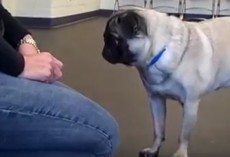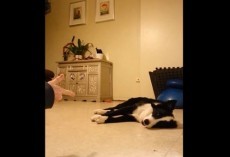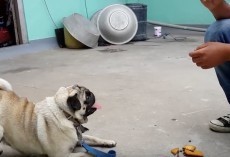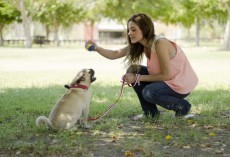Do you blame your Pug if he's afraid when in a new situation? Some dogs just take more time to warm up to new people and places, and that's okay. You can keep him on a leash and tell people to stay away until he gets used to them and implement other tips that can help him overcome his anxiety.
Your Dog’s Emotional Response
Nearly all reactivity is rooted in fear. Your dog’s aggressive behavior causes people to retreat, and then your dog feels safer. NEVER PUNISH A DOG FOR REACTIVE BEHAVIOR. Your dog is actually giving you important information that can help keep both your dog and other people safe. He is telling you that he is too close to what is making him anxious – in this case, people.
Management
You need to keep your dog away from people he is afraid of while you teach him that people can be trusted and that, in fact, good things happen when people are around.• When walking your dog, if you see someone ahead, cross the street, turn around, or wait behind a car. Make your walks fun.
• In your home, don’t bring your dog out when people are over.
• Reduce your dog’s arousal level by not permitting fence fighting in your yard and preventing your dog from barking at people outside your home.
• If you have a small dog, recognize that carrying your dog around gives him the confidence and opportunity to snap or bite another person.Changing Your Dog’s Emotional Reaction
Strangers Outside Your Home
Your ultimate goal is to teach your dog to be comfortable around people. You want to change his emotional response from “people are scary” to “people make good things happen”. Work with your dog far enough from strangers that your dog doesn’t react. If your dog does react, you are too close and need to move back.When your dog sees a person, start giving your dog tiny treats, one after another. Save the yummiest food for this exercise, so your dog learns “scary person = steak” (or string cheese or turkey hotdogs or whatever else your dog loves).
Don’t move too close too fast. The most difficult part of this exercise is having enough patience to avoid stressing your dog.
Guests in Your Home
Give your dog a safe place to go where he can relax, and let him stay there while there are people in your home. Keep a leash and treats by the door, so you can take him to his safe place when someone shows up unexpectedly.
Try a white noise machine or music to help block out the sounds of company.People Who Live With You
It can be very disappointing to bring home a new dog and find that the dog doesn’t like your spouse, housemate, or other person living in your home. If this happens, it’s important that this person essentially ignore the dog, not look at him, not reach out to him, etc. People can’t force a dog to trust them, but they CAN show the dog gradually over time that they are safe.
If your dog doesn’t like your child, that’s a more serious issue. If he is reacting to something your child does, like picking up or falling on your dog, that’s one thing. Help your dog escape to a safe place.Regular Visitors to Your Home
You may have regular visitors, such as relatives, neighbors, or close friends. You want your dog to be comfortable with these visitors and not have to go to his safe place every time they visit. Remember, though, that each of these people, regardless of how close they are to you, is a stranger to your dog.You can also train your dog to run to his “safe place” for a Kong stuffed with his favorite foods.
Remember that one visitor is not the same as multiple visitors. Even if your dog learns to be comfortable around your best friend, your best friend’s family may be more than your dog can handle.
Keep the Faith
It is extraordinarily rewarding to see a people – reactive dog learn to tolerate, or even welcome, people. Keep a simple record of breakthroughs to refer to when you feel discouraged.Key Points to Remember:
When working with your dog, keep him at a distance where he can remain calm. If your dog reacts, you are too close. Do not force interaction. It’s best if people let your dog decide if and when to approach.Management accomplishes two things: It keeps your dog from practicing the behavior, and it helps your dog feel safe.
Reward any time your dog remains calm around people. Keep small containers of treats throughout the house and take a treat bag on walks to ensure there are no missed opportunities.
Still Need Help?
Your Dog’s Friend is a 501-c3 non-profit organization that educates and supports dog parents. We offer behavior and training advice; sponsor FREE workshops on a variety of topics.
If you do move in with a significant other or friend, don't expect Fido to be best friends with them right away, especially if he has anxiety. Like Your Dog's Friend suggests, tell them to not pay attention to your pup, but rather allow your Pug to get slowly used to them.
Remember positive reinforcement is always helpful when you're training your doggy how to overcome barking, lunging, and being fearful in general. With some training, affection, and patience your doggy should be able to overcome his anxiety and not be a threat to people.











Chad Kilgore
- Edit
Jay Stover what would you do
Martine Theelen Schinck
- Edit
Mitchel
Olivia Amy
- Edit
wow. an awesome dress for pug lover.
not sold in store. pick yours before ending stock
just click ===> http://bit.ly/2lYNW19